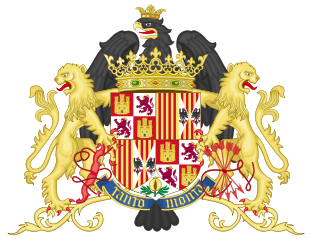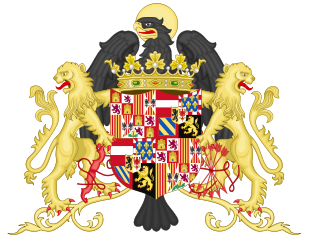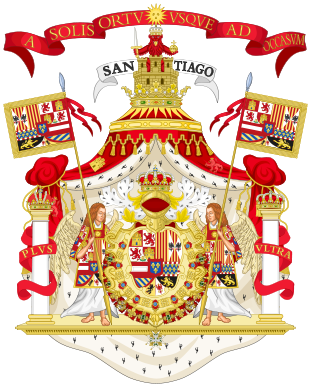- Coat of arms of the King of Spain
-
Coat of arms of the King of Spain 
Details Armiger Juan Carlos I Adopted Used unofficially since November 22, 1975. Adopted January 21, 1977 Crest Spanish Royal Crown Escutcheon Quarterly: Castile, León, Aragon, and Navarre; enté en point: Granada; inescutcheon Bourbon (Anjou Branch) Supporters Cross of Burgundy Orders Order of the Golden Fleece Other elements Base point, the yoke with ribbons and the sheaf of five arrows. Earlier versions see below The blazoning of the coat of arms of the King of Spain is set out in Title II, Rule 1, of Spanish Royal Decree 1511 of 21 January 1977, by which the Rules for Flags, Standards, Guidons, Banners, and Badges were adopted.
Contents
Quartered shield
The shield is divided into four quarters, blazoned as follows:
- 1st, gules a castle or, triple-embattled and voided gate and windows, with three towers each triple-turreted, of the field, masoned sable and ajoure azure, which is for Castile;
- 3rd, or, four pallets gules, which is for Aragon;
- 4th, gules a cross, saltire and orle of chains linked together or, a centre point vert, which is for Navarre;
Argent enté en point, with a pomegranate proper seeded gules, supported, sculpted and leafed in two leaves vert, which is for Granada.
Inescutcheon azure bordure gules, three fleurs-de-lys or, which is for Bourbon-Anjou.
Joined to the shield, the red saltire of Burgundy and, to the dexter and sinister of the base point, the yoke gules in its natural position with ribbons, of the field, and the sheaf of five arrows gules with the arrowheads inverted and ribbons, of the field.
All surrounded by the chain of the Golden Fleece and crowned with a crown of the same metal and precious stones, with eight rosettes, five visible, and eight pearls interspersed, closed at the top by eight diadems also adorned with pearls and surmounted by a cross on a globe, which is the royal crown of Spain.[1]
In 1969, General Francisco Franco appointed Juan Carlos I as his "successor to the Headship of the Spanish state with the title of King" but gave him the new title of Prince of Spain instead of the traditional title of Prince of Asturias. From 1971 to 1975, Juan Carlos as Prince of Spain used a coat of arms which was virtually identical to the one later adopted when he was became King in 1975. The earlier coat of arms differed only that it featured the royal crown of a Crown Prince of Spain, the King's royal crown has eight half-arches of which five are visible, while the Prince's one has only four half-arches of which three are visible.[2]
Ornamented versions of the historical royal coats of arms
- For common versions and the changes of the heraldic charges and the divisions of the field, see Coat of arms of Spain.
Royal Arms Monarch Supporters Other ornaments Motto House of Trastamara (1475–1506) 
The Catholic Monarchs
(1474–1492)- Two lions
(adopted by John II of Castile)
- The former royal crown

The Catholic Monarchs
(1492–1504)- The Eagle of St John
- Two lions
(as displayed at the Church of St Paul in Valladolid)
- The crown of the Catholic Monarchs
- A yoke
- A sheaf of five arrows
Tanto monta
(Spanish: They amount to the same)
Ferdinand II of Aragon
(1504–1516)
(After the death of queen Isabella)- The former royal crown of Aragon

Joanna of Castile
(1504–1506)- The Eagle of St John
- Two lions
(as displayed at at the fachade of the Church of Saint Mary the Royal in Aranda de Duero, Burgos Province)
- The former royal crown
- A yoke
- A sheaf of five arrows

Philip I of Castile
(1504–1506)
(with Joanna)- The Eagle of St John and one lion
(as displayed on his seal)
- The royal crest of Castile
- The former royal crown
- A helmet
- Gold and ermine mantling
- The Order of the Golden Fleece
Qui voudra
(Old French: Whoever will accept)House of Habsburg (1506–1700) 
Charles I
King of Castile
(1506–1516)
Spanish Monarch
(1516–1520)- The Eagle of St John and one lion
(as displayed on his seal)
- The royal crest of Castile
- The former royal crown
- A helmet
- Gold and ermine mantling
- The Order of the Golden Fleece
Plus oultre
Later Plus ultra
(Latin: Further beyond)
Charles I
(1520-1530)- The Eagle of St John and one lion
- The royal crest of Castile
- The former royal crown
- A helmet
- Gold and ermine mantling
- The Order of the Golden Fleece
Plus ultra

Charles I
Charles V
as Holy Roman Emperor
(1530-1556)- The Double-headed eagle
(in some variants showed within his arms)
- The imperial crest
- The imperial crown
- A helmet
- Gold and ermine mantling
- The Order of the Golden Fleece
Plus ultra

Philip II
(1556-1598)- Two lions
- The royal crest of Aragon
- The royal crest of Castile
- The royal crest of Portugal
- The former royals crowns of Aragon, Castile and Portugal
- Three helmets
- Gold and ermine mantling
- The Order of the Golden Fleece
Dominus mihi adjutor
(Latin: Lord, give me counsel) V. 6, Psalm 117
Philip III
(1598-1621)- Two lions
- The royal crest of Aragon
- The royal crest of Castile
- The royal crest of Portugal
- The former royals crowns of Aragon, Castile and Portugal
- Three helmets
- Gold and ermine mantling
- The Order of the Golden Fleece
Ad utrumque
(Latin: Ready for either alternative)
Philip IV
(1621-1665)
Charles II
(1665-1700)- Two lions
- The royal crest of Castile
- The former royal crown
- A helmet
- Gold and ermine mantling
- The Order of the Golden Fleece
Ad utrumque
House of Bourbon (1700–1808 / 1813-1868 / 1874-1931) 
Philip V
(First reign)
(1700-1724)
Louis
(1724)
Philip V
(Second reign)
(1724-1746)
Ferdinand VI
(1746-1759)
Charles III
(1759-1761)- Two angels
(as well as a lance with two royal standards) - The Pillars of Hercules
- The sun
- The royal crest of Castile
- The former royal crown
- The royal mantle
- The modern royal crown
(with eight half-arches) - A helmet
- Gold and ermine mantling
- The Order of the Golden Fleece
- The Order of the Holy Spirit
- A solis ortu usque ad occasum
(Latin: From the rising up of the sun unto the going down of the same) V. 3, Psalm 112 - Plus ultra
- Santiago

Charles III
(1761-1788)
Charles IV
(1788-1808)
Ferdinand VII
(1808)
Ferdinand VII
(Restored)
(1808-1833)
Isabella II
(1833-1868)
Alfonso XII
(1874-1885)
Alfonso XIII
(1886-1931)- Two angels
(as well as a lance with two royal standards) - The Pillars of Hercules
- The sun
- The royal crest of Castile
- The former royal crown
- The royal mantle
- The modern royal crown
(with eight half-arches) - A helmet
- Gold and ermine mantling
- The Order of the Golden Fleece
- The Order of Charles III
- A solis ortu usque ad occasum
- Plus ultra
- Santiago
French occupation (1808–1813) 
Joseph Bonaparte
(1808–1813)- Two sceptres
- The modern royal crown
(with eight half-arches) - The royal mantle
- The Order of the Golden Fleece
- The Legion of Honour
House of Savoy (1870–1873) 
Amadeus
(1870–1873)- The modern royal crown
(with eight half-arches) - The royal mantle
- The Order of the Golden Fleece
House of Bourbon (1931) 
Alfonso XIII
(1931)- Two angels
(as well as a lance with two royal standards) - The Pillars of Hercules
- The modern royal crown
(with eight half-arches) - A helmet
- Gold and ermine mantling
- The Order of the Golden Fleece
- The Order of Charles III
- Plus ultra
See also
References
- ^ Coat of arms of His Majesty the King of Spain. The Royal Household of the King of Spain. Retrieved 19th October 2011.
- ^ (Spanish) Spanish Decree 814 of 22nd April 1971. Boletín Oficial del Estado, Official Gazette of the Spanish Government, no. 99. Retrieved 19th October 2011.
External links
- Description Standard and Coat of Arms of the King, Flags of The World website
- Origins and History of the Spanish coat of arms (Spanish)
Coats of arms of Spain Autonomous communities Andalusia • Aragon • Asturias • Balearic Islands • Basque Country • Canary Islands • Cantabria • Castile-La Mancha • Castile and León • Catalonia • Extremadura • Galicia • Community of Madrid • Region de Murcia • Navarre • La Rioja • ValenciaAutonomous cities Royal Family The King • The Prince of AsturiasCategories:- Personal coats of arms
- Spanish coats of arms
- Spanish monarchy
Wikimedia Foundation. 2010.
